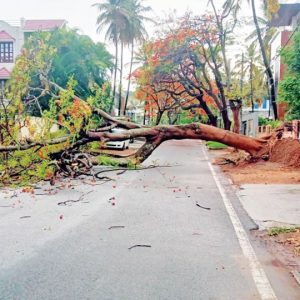University of Mysore signs MoU with Forest Department to undertake DNA profiling
Mysore/Mysuru: In a significant step in the conservation of vultures, the Genetics and Genomics Department of University of Mysore (UoM) has signed a Memorandum of Understanding (MoU) with Forest Department for conservation of vultures through DNA profiling.
Under the arrangement, the University will take up studies for vulture conservation and will set up a vulture gene bank. The University will undertake a scientific study and research on biodiversity of vultures at the Vulture Conservation Reserve, Ramadevarabetta in Ramanagara.
The MoU was signed in the presence of UoM Vice-Chancellor Prof. G. Hemantha Kumar, Deputy Conservator of Forests, Male Mahadeshwara Wildlife Division V. Yedukondalu, Deputy Conservator of Forests, Ramanagara Division V. Devaraj and Project Principal Convener and Chairperson of Department of Studies in Genetics and Genomics Prof. S.S. Malini on May 12.
Speaking on the occasion, Prof. Hemantha Kumar termed the MoU as historic and is aimed at nature conservation. “Both the University and the Forest Department can play a major role in the area of biodiversity. Today, vultures are declining and are on the verge of extinction. The survival of any animal is based on its genetic structure. We will undertake DNA profiling of vultures. Through the DNA tests, vulture gender can be determined and in turn, it will help in increasing its numbers,” he explained.
“The survival of any animal is due to the gene’s environmental interaction based on basic principles of genetics. With Genetics and Genomics, we can understand the factors that are leading to diminishing population of vultures,” he added. The VC also proposed to organise lecture series to the officers from the Forest Department on the importance of the application of genetics in wildlife management.
Killer chemical diclofenac
The reason for the fast disappearance of vultures at Ramadevarabetta is attributed to shortage of food. Prof. Malini said that vultures are scavengers which feed on carcasses of the dead. In the past, villagers would dump or discard dead cows and buffaloes in the nearby forest and vultures fed on them.
But in recent years, farmers no longer dump these carcasses and instead bury them, leading to shortage of food for vultures. Extensive research has identified the cause of the decline to be diclofenac, a non-steroidal anti-inflammatory drug used to treat livestock. Vultures feeding on the carcasses of animals treated with the drug suffer renal failure and die, she noted.
Despite placing a ban on the veterinary use of diclofenac in 2006, the human doses were misused for cattle treatments. Though the usage of diclofenac has reduced considerably now, it is continued to be misused in some places.
“Earlier, Ramadevarabetta and its surrounding places were home to a good number of Long-Billed Vultures before their population started to dwindle, owing to food scarcity and human disturbance among other factors. Conservation of vultures is the only way to stop extinction. That is why DNA profiling is being undertaken to improve the reproductive strength of the vultures,” Prof. Malini added.
Deputy Director of Bombay Natural History Society and Programme Head, National Level Vulture Conservation team, Dr. Vibhu Prakash Mathur also spoke.






Wondering why UoM needs to save these winged vultures, when vultures without wings are abundant in the corridors of power aka GoK
Tragedy
Jai Hind